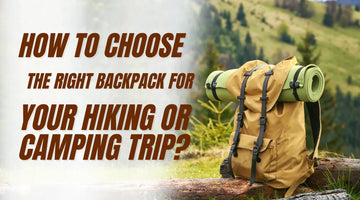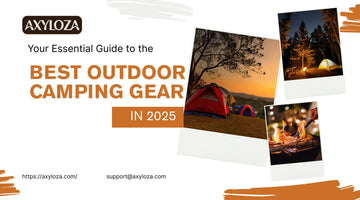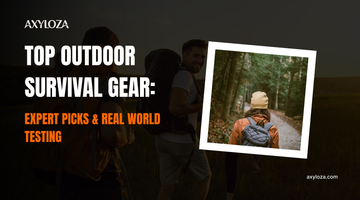When preparing for an outdoor trip, picking the right gear can define how smooth your adventure goes. Out of all your essentials, the backpack for hiking is the one item you’ll rely on the most.
Whether your plan is a quick day hike or a multi-day camping experience, knowing how to select the right pack ensures better comfort, proper organization, and reliable performance.
This step-by-step guide will help you make a well-informed decision.
Why Choosing the Right Backpack Matters
Selecting a good backpack is not just about looks; it’s about improving your journey. The right pack will provide comfort, keep your essentials organized, and stand strong against tough outdoor conditions.
Comfort, Functionality & Safety
Carrying weight over long distances is only possible if your pack is comfortable. A reliable backpack for hiking spreads weight evenly, easing the strain on your shoulders and back.
Features such as adjustable straps, hip belts, and multiple compartments add functionality, allowing quick access to gear like water bottles, maps, or snacks. Safety also matters; a stable backpack helps prevent slips on rocky terrain, while reflective elements improve visibility during night or low-light treks.
Avoiding Back Pain and Gear Failure
The wrong backpack can lead to body strain or even leave you without critical gear. Poor-fitting packs put excess pressure on your back, often resulting in pain.
Likewise, weak stitching or thin fabrics might tear under load. Spending time choosing carefully will prevent these problems, giving you a smoother, stress-free trip.
Types of Backpacks for Outdoor Adventures

Not all backpacks are the same; each type is designed for specific needs. Knowing the styles helps you choose the most suitable one for your outdoor goals.
Daypacks (1–2 day hikes)
For short trips, a small backpack for hiking or a daypack is the best choice. These packs generally range from 0.7–1.24 cubic feet (20–35 liters) of space and are lightweight. They can carry essentials like snacks, water, and a light jacket, making them ideal for casual hikers or beginners.
Overnight Packs
If your plan includes one night outdoors, go for packs between 1.24–1.8 cubic feet (35–50 liters). These overnight packs can hold your tent, sleeping bag, food, and clothing without being bulky. A good balance between size and comfort is key here.
Multi-Day & Extended Trip Packs
For longer hikes, larger backpacks for hiking and camping with 1.8–2.5 cubic feet (50–70 liters) or more are necessary. These are built to carry everything: food, cooking gear, sleeping equipment, and stand up to rugged paths.
Hydration Packs
A hydration backpack for hiking is designed for quick water access. It includes a hydration reservoir with a tube for sipping while walking. These are best for active hikers who want lightweight storage with a focus on hydration.
Key Factors to Consider When Choosing a Backpack
Your hiking goals, trip length, and gear type determine the kind of backpack you’ll need.
Trip Length and Duration
Short treks need small packs, while extended trips require more space. For weekend adventures, the best backpack for light hiking may be enough, while longer trails call for packs with higher capacity.
Load Capacity
Capacity is measured in liters or cubic feet (1 liter ≈ 0.035 cubic feet). Choose based on how much gear you plan to bring. Avoid overpacking—extra weight adds unnecessary strain.
Weight of Gear You Plan to Carry
If you’re a minimalist, a lightweight backpack for hiking may suit you, but make sure it can handle your load safely. Comfort should never be sacrificed for weight savings.
Terrain & Weather Conditions
On rough terrains, stronger backpacks with proper suspension systems are essential. In wetter climates, waterproof backpacks for hiking will keep your items protected from rain.
Gender-Specific or Unisex Fit
A hiking backpack for women usually has narrower shoulder straps and shorter torso length for a better fit, while hiking backpacks for men may be wider. Unisex models are available, too, but always try them on for comfort.
Backpack Fit and Sizing Guide

The best backpack is one that fits you properly. Getting the right size helps prevent injuries and maximizes comfort.
How to Measure Your Torso Length
Measure from the base of your neck (C7 vertebra) down to the top of your hip bones. Sizes typically fall into small (15–17 inches), medium (18–19), and large (20+)
Hip Belt Sizing and Adjustment
Your hip belt should rest securely on your hip bones, transferring weight from your shoulders to your hips.
Shoulder Straps and Load Lifters
Straps should contour your shoulders without leaving gaps. Load lifters help pull the pack closer for stability.
Trying It On with Weight for a Real Fit
Test the pack by loading 10–20 pounds and walking around. Adjust straps and belts until the backpack feels balanced and supportive.
Must-Have Backpack Features
Certain features make a huge difference in performance and usability.
Internal vs. External Frames
Internal frames provide agility and flexibility by keeping the load close to your body. External frames offer better airflow and are ideal for heavy loads.
Compartments and Accessibility
Backpacks with multiple compartments and easy-access side zippers make organizing and retrieving gear easier.
Ventilation and Back Panel Design
Look for mesh or ventilated panels to keep airflow moving, especially on warm hikes.
Hydration System Compatibility
Many backpacks now include compartments for hydration bladders, making them the ideal backpack for hiking.
Attachment Loops (for trekking poles, tents, etc.)
Loops and straps help carry extras like trekking poles, sleeping pads, or ice axes.
Material and Build Quality
Durable construction determines how long your backpack will last.
Waterproofing or Rain Covers
The best backpack for hiking comes with waterproof fabrics or rain covers to keep gear safe in wet weather.
Abrasion-Resistant Fabrics
High-denier nylon or polyester resists tears and scratches from rough environments.
Zippers, Buckles, and Stitching Quality
Strong zippers, reinforced buckles, and high-quality stitching ensure reliability on demanding trails.
Best Brands and Budget Options
Good brands offer tested designs across different price points.
Trusted Brands in the Market (e.g., Osprey, Deuter, REI, Gregory)
Osprey is known for excellent ventilation, Deuter for comfort, REI for affordability, and Gregory for customizable fits.
Value-for-Money Picks for Beginners
Affordable choices like Quechua or Amazon Basics are great starter packs. They deliver decent features at a lower cost.
Premium Picks for Serious Trekkers
Top-quality models like the best hiking backpacks for men or best hiking backpacks for women from Patagonia or Arc’teryx are ideal for advanced hikers who need durability and innovation.
Backpack Maintenance and Storage Tips
Taking care of your pack extends its lifespan.
How to Clean Your Backpack
Empty completely, brush off dirt, and spot-clean with soap and water. Air dry fully before storing.
Proper Storage to Prolong Lifespan
Store loosely in a dry, cool place. Avoid compressing long-term to maintain shape and structure.
Conclusion
Selecting the right backpack for hiking is about balancing comfort, features, and personal needs. By understanding fit, durability, and design, you’re ready for enjoyable outdoor adventures.
Ready to start your journey? Explore a wide collection of hiking backpacks for sale at Axyloza. Find top options such as backpacks for hiking and a lightweight backpack for day hiking.
FAQ
What size backpack do I need for a 3-day hiking trip?
Go for 1.4–2.1 cubic feet (40–60 liters). It’s enough space for food, clothing, and shelter while staying manageable.
What’s the difference between internal and external frame backpacks?
Internal frames are lightweight and flexible. External frames are rigid, offer ventilation, and support heavy loads better.
How do I measure my torso for the right backpack size?
Measure from your neck’s base down to your hip bones, then compare with the pack’s sizing chart.
Should I choose a men’s or women’s backpack?
The best backpack for women hiking is shaped for women’s anatomy. A hiking backpack for men may suit broader builds. Always try both for comfort.
Can I use a regular school or travel backpack for hiking?
It works for light hikes, but dedicated backpacks for hiking have superior support and features.
How heavy should my backpack be when packed?
Keep it at 10–15% of your body weight for long trips, but never exceed 20%.




